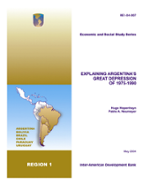Explaining Argentina's Great Depression of 1975-1990
Date
May 2004
This paper is part of the project "Explaining Economic Growth Performance" launched by the Global Development Network. The authors revisit the evidence on growth in Argentina, looking at aggregate data as well as national income data by sector. This paper's primary hypothesis is that government policies during 1975-90 increased capital costs, reducing the capital per worker and thereby inducing a labor reallocation. This analysis assumes that the elasticity of substitution between capital and labor is higher in the service industry, so that new entrants to the labor force were allocated to the service sector where it was easier to substitute labor for capital.



